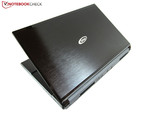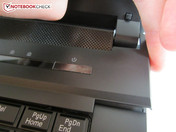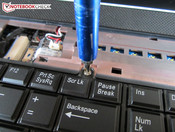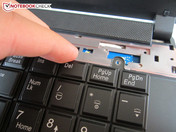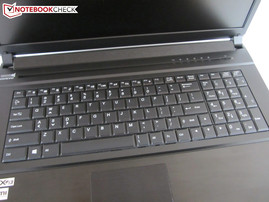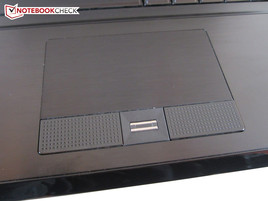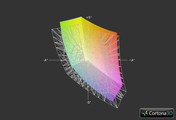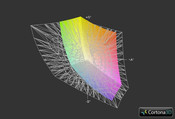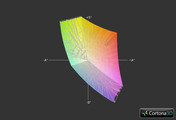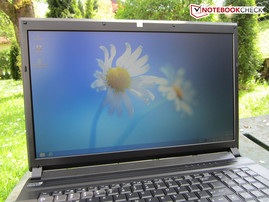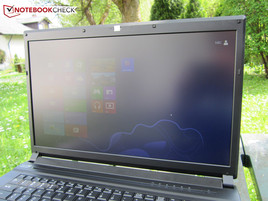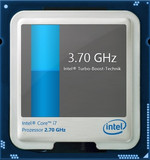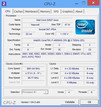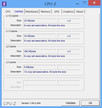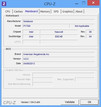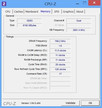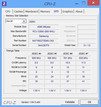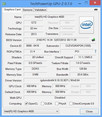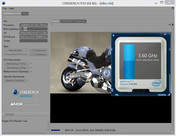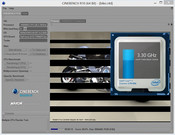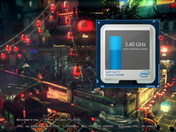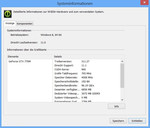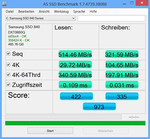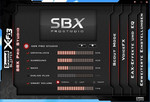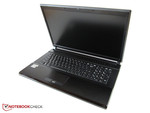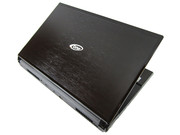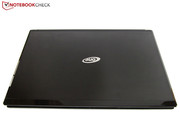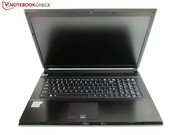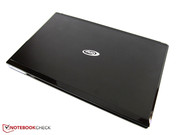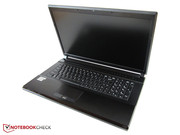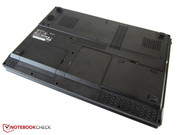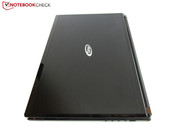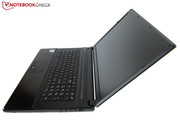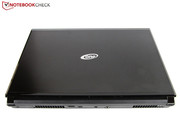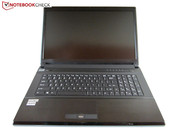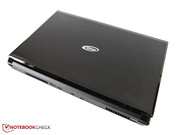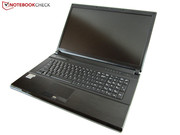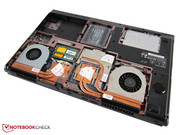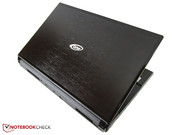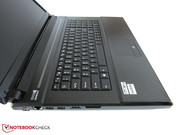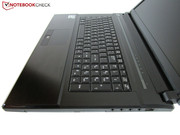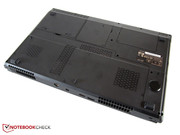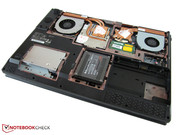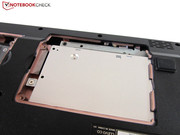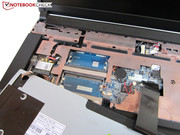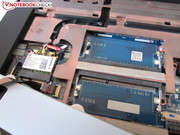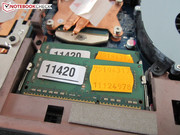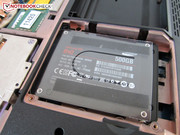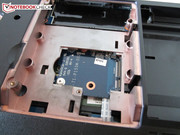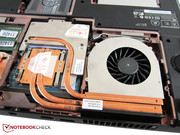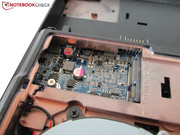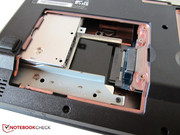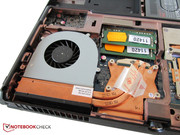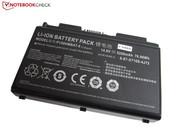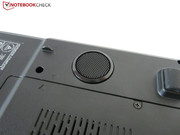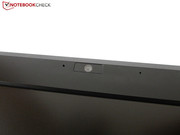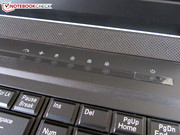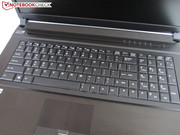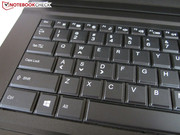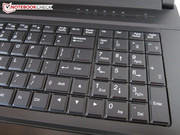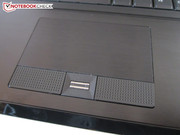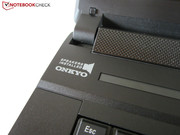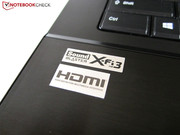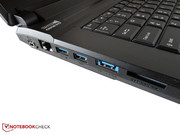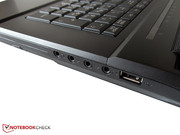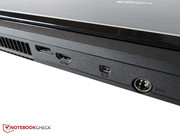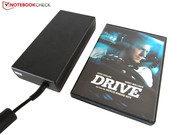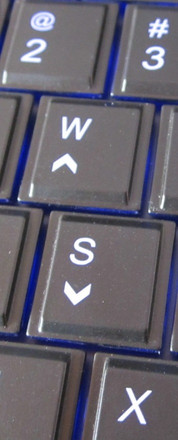Review One K73-3N (Clevo P170SM) Notebook
One doesn't just sell notebooks from well-known manufacturers like Asus, Dell, and Toshiba - they also offer their own products on their homepage. One of the newest and most exciting additions is the K73-3N. In line with the company's philosophy, customers can configure the 17-inch notebook down to the most minute detail.
The brand-new motherboard features the HM87 chipset and is home to a speedy CPU based on Intel's new Haswell architecture. A DirectX 11 capable GPU - part of Nvidia's 700 series - handles graphics duties. In addition to the GeForce GTX 770M installed in our review model, One also offers the top-rated GeForce GTX 780M as an option.
Also on board are up to 32 GB DDR3-RAM (4x 8192 MB) and a DVD-RW/Blu-ray drive. Four RAM slot might still be somewhat common - but two mSATA and two 2.5-inch hard drives slots are definitely not something you see every day.
One offers dozens of HDDs, SSDs, and hybrid drives in their configuration tool. The company seems to favor Solid State Drives from Samsung - not surprising, since these drives combine high performance with an acceptable price. The Wi-Fi module, the warranty, and the OS can also be changed or upgraded.
Our review notebook is a pre-production model with an ES (Engineering Sample) CPU - the stated test parameters and benchmark results are therefore subject to change. At the time of writing, only Windows 8 was supported - so we expect to see some updates to the BIOS and the drivers.
Case
One uses the P170SM barebone chassis from Clevo. One of the key differences to the 17-inch siblings P177SM and P370EM is the fact that the lid and palm rest do not feature a rubberized finish, but are covered with a thin sheet of aluminum instead. The brushed finish looks pretty upscale - but we question Clevo's decision to stick with the highly reflective and extremely delicate glossy borders of the predecessor P170EM. At least the display bezel is now matte instead of glossy.
Physically and visually - partly because of the very square design - the notebook is a behemoth: the size of 412 x 276 x 53 millimeters makes it one of the largest systems currently available. The large thickness has its advantages, as the notebook is quite sturdy. The base unit is able to resist even strong pressure, although the lid could be a little more resilient.
Because of the substantial weight of 3.7 kilograms (with SSD), transporting the notebook is not a joyful experience. As a desktop replacement, the K73-3N is of course better suited for permanent desk duty. The build quality is more than adequate and most transitions are flawless.
The design of the P170SM is a matter of taste - it's certainly not state-of-the-art, nor is it playful. The quality of the barebone system falls short of 17-inch competitors like the Alienware M17x R4 or the Asus G75. Overall, the notebook is nonetheless a sturdy and understated high-end platform.
Users interested in keeping their notebook clean will have to break out a cleaning cloth frequently: the dark surface areas prove to be a magnet for dust particles and fingerprints. Which barebone - P170SM or P177SM - ends up being the better choice depends on the preferences of the user, as the systems are more or less evenly matched.
Connectivity
Ports
The port selection mirrors the Haswell sister-models P150SM, P157SM, and P177SM to a tee. Three USB 3.0 ports (one of them is an eSATA/USB combo-port) are impressive - and so are the four audio jacks, which enable 7.1 output. In other words: with the right selection of cables, a surround system can be hooked up to the notebook. Three digital display outputs (HDMI, DisplayPort, and Mini DisplayPort), an infrared sensor, and a Mini FireWire port round out the selection.
The other ports are standard fare: there is an RJ-45 Gigabit LAN connector, a Kensington lock slot, and one USB 2.0 port. The integrated card reader supports almost 10 different types of cards (see column on the right). The webcam offers Full HD resolution (2 MP). A fingerprint reader is located between the two touchpad mouse buttons.
As far as the location of the ports is concerned, other manufacturers should take heed: the placement towards the rear ensures that the workspace doesn't get crowded even with a lot of devices plugged in. An external mouse, for example, can be used without any unwanted collisions.
Wireless Communication
Our review model features an Intel Centrino Ultimate-N 6300, which supports standards 802.11 a/g/n. According to the homepage, the PCIe card not only supports 2.4 GHz, but also 5.0 GHz and can handle data transfer rates of up to 450 Mbit/s. The module does not support Bluetooth, however - and the very good range only partly makes up for that deficit.
Maintenance
Clevo makes maintaining and upgrading the system exceptionally easy. While other notebook manufacturers just provide access to the RAM and the hard drive - see for example the Toshiba Qosmio X870 - the One K73-3N allows the user to also get to the fan, the graphics card, and the processor (all of which can be replaced).
The maintenance covers on the bottom can be removed with a regular Phillips screwdriver. The photos in the right hand column document accessibility - some components are somewhat hidden. One of the mSATA slots is located under the space for the primary 2.5-inch hard drive; the secondary 2.5-inch hard drive sits under the optical drive. The four RAM slots are split up between both sides of the motherboard, which means that in order to gain access to the second set (and also the wireless module), the keyboard has to be removed (see below).
Software
Most barebone-resellers refrain from cluttering the hard drive with additional software. One is no different - and the K73-3N is absolutely free of bloatware.
Accessories
Our pre-production review system most likely doesn't include all the accessories the final production version will ship with. A driver-DVD was in the box, however, a user manual was not included. The 230 watt power adapter weighs 900 grams and measures 178 x 88 x 35, which might be too large for some notebook bags. Clevo also includes the popular 8-cell battery P150HMBAT-8, which features a capacity of 77 Wh.
Warranty
The notebook is covered against defects for a period of 12 months. The basic warranty can be extended to two or three years for an additional fee, as can the pickup & return service.
Input Devices
Keyboard
Clevo experts will recognize the keyboard, as it looks to be a carry-over from the predecessor P170EM. They keyboard is not completely identical though - the FN key is now located next to the right ALT key instead of the left one and the > < | - key also moved. The German version of the keyboard also has to make do with an Enter key that doesn't span two rows, but sits in a single row instead. Touch typists will need some time to get used to the layout.
After some practice, we were able to use the keyboard without issues. Clevo appears to have reduced the stiffness of the keys, which is something we criticized in our previous review. The keyboard now feels a little softer, although the feedback is still well defined and precise. We liked the click-point, feedback, and the sound the keys produce. Fortunately, we also didn't encounter the issues with key inputs not being recognized occasionally, which is something that marred the typing experience with the first generation of the backlit keyboard.
Speaking of backlit: the included software (see screenshot) allows the user to assign different colors to three sections. A late-night gaming session in a dimly-lit room is certainly possible.
Touchpad
The touchpad measures 90 x 48 millimeters. On paper, its stats look good: there are horizontal and vertical scroll bars as well as multi-gesture support for turning images, scrolling, and zooming.
When we started putting the touchpad through its paces, we uncovered a few shortcomings: first of all, the surface is flush with the palm rest, which makes locating the edges difficult. The touchpad is often imprecise and cursor control suffers at times - especially if the fingers are wet. The textured surface also doesn't allow fingers to glide easily.
As far as the overall usability of the touchpad is concerned, Clevo definitely has room for improvement. Other barebones - like the W150ER and the P150SM - show that Clevo generally has issues with touchpad quality.
Display
Clevo uses the same 17.3-inch Chi Mei N173HGE-L11 (CMO1720) Full HD display panel also found in the high-end P177SM barebone. It's not surprising that the measurements are very similar: we recorded a maximum brightness of 290 cd/m² for the One K73-3N, which is quite a bit higher than the average of 200-250 cd/m².
| |||||||||||||||||||||||||
Brightness Distribution: 81 %
Center on Battery: 138 cd/m²
Contrast: 869:1 (Black: 0.35 cd/m²)
62.6% AdobeRGB 1998 (Argyll 3D)
86.3% sRGB (Argyll 3D)
61.4% Display P3 (Argyll 3D)
The black level is also very good: 0.35 cd/m² ensures that dark scenes appear mostly black and not gray. We also can't complain about the contrast ratio of 870:1, which is better than what most competitors are capable of. The average notebook display tops out at 300 to 500:1. Considering this is a non-glare screen, colors are quite vivid. The small issues with color accuracy (see CalMAN screenshots) are not severe enough to be noticeable to the average user.
In theory, the K73-3N should be perfectly suited for outdoor use, since the screen is both bright and non-glare. Unfortunately though, the brightness decreases by 50% when the notebook is running on battery power. We don't know if this is a bug or a feature which is supposed to increase the battery life. Those wanting to use the notebook outside should make sure that an outlet is nearby. The 15-inch P150SM also has the same issue.
Multiple windows are no problem thanks to the resolution of 1920x1080 pixels. Even though the GeForce GTX 770M is pushed to its limits at times, we think that Full HD is the perfect resolution. The times where HD+ resolution (1600x900) was sufficient for gaming are a thing of the past. The display does very well with non-native resolutions - even at 1366x768 pixels, the sharpness is acceptable.
Horizontally, the viewing angle stability is acceptable despite a noticeable yellow cast. Typically for TN panels, deviations from the vertical - especially from below - quickly result in a deterioration of the picture quality. That doesn't mean that the K73-3N is worse than the competition: less expensive TN panels often have issues with the picture quality much sooner.
For our readers who might wonder about the slightly "grainy" appearance: this is normal for the Chi Mei N173HGE-L11.
Performance
Processor
Since AMD's processors and APUs are mostly found in entry and mid-level products, Intel's new Haswell generation doesn't really face competition in the upper performance echelon. Especially the quad-core CPUs offer excellent performance and should provide adequate power for years to come.
Our review model is equipped with the 2.7-3.7 GHz Core i7-4800MQ, which features a 6 MB L3 cache. Although the Core i7-4900MQ is a bit faster (2.8-3.8GHz) and features a larger cache (8 MB), the price premium is only partially justified.
Intel claims a TDP of 47 watts. This means that the new Haswell quad-core processors consume slightly more power than the Ivy Bridge models, which have a TDP of 45 watts.
The manufacturing process hasn't changed. Intel sticks with the 22 nm process according to their Tick-Tock strategy: Haswell "only" offers a new micro-architecture. The GPU should see the most significant jump in performance - Intel claims that the HD Graphics 4600 is significantly faster than the HD Graphics 4000.
Potential customers are probably more interested in the K73-3N's switchable graphics. Not surprisingly, Clevo uses Nvidia's Optimus technology, which automatically uses either Intel's integrated graphics or the Nvidia GPU. The goal is an attempt to conserve power.
Turbo Boost
Aside from the Hyperthreading technology, which simulates virtual cores, Intel processors have used Turbo Boost for several years. This important technology not only has benefits for professional users - gamers will also see improved performance. Turbo Boost increases the core frequency by several 100 MHz under load. To get to the maximum possible frequency, the cooling system has to be able to handle the increased heat output.
The P170SM is a mixed bag in that aspect: during the single-core benchmark test, the Core i7-4800MQ hovers around 3.6-3.7 GHz; during the multi-core benchmark tests, the Turbo is less active and only manages 3.3 GHz instead of the theoretical maximum of 3.5 GHz. The P177SM showed similar results.
CPU Performance
CPU-focused benchmarks, like the Cinebench R11.5 test, show the effect of the weaker Turbo. While the Core i7-4800MQ manages to be about 7% faster during the single-CPU test than the older but identically clocked Core i7-3740QM (1.64 vs. 1.53 points), the difference is a paltry 4% for the multi-CPU test (7.19 vs. 6.93 points). If the Turbo could develop its full potential, the Core i7-4800MQ should be about 10% faster.
Of course, percentage points don't tell the whole story: during everyday use, there is not going to be a noticeable difference. If money is an issue, it might be better to get a more advanced graphics card - even the less expensive quad-core CPUs offer more than enough performance.
| Cinebench R10 | |
| Rendering Single CPUs 64Bit (sort by value) | |
| Core i7-4800MQ | |
| Core i7-3630QM | |
| Core i7-3740QM | |
| Rendering Multiple CPUs 64Bit (sort by value) | |
| Core i7-4800MQ | |
| Core i7-3630QM | |
| Core i7-3740QM | |
Graphics Card
The specs of the GeForce GTX 770M are similar to the GeForce GTX 670MX, which is also part of the Kepler generation and is manufactured using the same 28 nm process. Both support DirectX 11, utilize 960 shader cores, have a memory bus width of 192-bit, and have 3072 MB of GDDR5 video RAM.
The main advantage of the GeForce GTX 770M is the higher clock speeds. The increase of 35% for the core (811 instead of 600 MHz) and an increase of 43% for the RAM (2004 instead of 1400 MHz) result in a significant increase in performance.
Even the previously third-ranked Nvidia GPU - the GeForce GTX 675MX - is clocked slightly slower (600/1800 MHz). In some benchmark tests the GTX 770M almost performs as well as the GeForce GTX 680M (720/1800 MHz).
The GeForce GTX 770M doesn't stand a chance against the high-end GeForce GTX 780M. This Kepler GPU contains 60% more shader cores (1536), 33% more RAM (4096 MB), and a wider 256-bit interface. Compared to the GeForce GTX 765M, the 770M does well, since the 765M only comes with 768 CUDA cores and 2048 MB GDDR5 RAM (128-bit interface).
Unfortunately, our review notebook came with an older GPU driver (ForceWare 311.27). Only a few games - for example BioShock Infinite - will reveal this as an issue. Official drivers from Nvidia were not available before the launch.
GPU Performance
We checked the DirectX 11 performance using Unigine Heaven 3.0. At the native resolution of 1920x1080 pixels, details set to high, and normal tessellation we saw a very respectable 49.5 fps - right between the GeForce GTX 675MX (~41 fps) and the GeForce GTX 680M / Radeon HD 7970M (~58 fps).
3DMark 13 shows the One K73-3N to be very fast indeed: the system scored 3392 points during the Fire Strike Test (GPU score), which is significantly better than the result of the GeForce GTX 765M (2479 points / Schenker W503). However, the GeForce GTX 780M offers about 50% more performance (5234 points / Schenker XMG P703).
| Unigine Heaven 2.1 - 1280x1024 high, Tesselation (normal), DirectX11 AA:off AF:1x (sort by value) | |
| GeForce GTX 770M | |
| GeForce GTX 765M | |
| GeForce GTX 680M | |
| Radeon HD 7970M | |
| GeForce GTX 780M | |
| 3DMark 11 - 1280x720 Performance GPU (sort by value) | |
| GeForce GTX 770M | |
| GeForce GTX 765M | |
| GeForce GTX 680M | |
| Radeon HD 7970M | |
| GeForce GTX 780M | |
| 3DMark 06 Standard Score | 22988 points | |
| 3DMark Vantage P Result | 19935 points | |
| 3DMark 11 Performance | 5354 points | |
| 3DMark Ice Storm Standard Score | 85154 points | |
| 3DMark Cloud Gate Standard Score | 15337 points | |
| 3DMark Fire Strike Score | 3184 points | |
Help | ||
Storage Solution
Our very large folder with various benchmark tests easily fits onto the 500 GB Solid State Drive. The 7 millimeter Samsung SSD 840 MZ-7TD500 is capable of outstanding performance due to its large size.
The sequential read and write speeds of 515 MB/sec and 322 MB/sec (AS SSD Benchmark) are very impressive. Access times are also very quick (0.1 read, 0.03 write) and don't lag behind the SATA III competition.
As we would expect from an SSD-equipped system, OS operations are exceedingly quick - it doesn't matter if the task is an installation, data transfer, or a program execution.
Some of our readers might ask why the SSD 840 is so much less expensive than the SSD 840 Pro. The answer: for the Pro-series, Samsung utilizes the longer-lasting and faster MLC flash instead of the less expensive TLC flash. During normal use, the differences are not that significant.
System Performance
Overall system performance is also impressive: with a PC Mark Vantage score of 21052 points, the gaming notebook outperforms most competitors - although the 17-inch family member One M73-2N (Core i7-3740QM, GeForce GTX 675MX, 128 GB Samsung SSD 830) managed a slightly higher score of 21174 points. The K73-3N has a clear edge in the PCMark 7 benchmark test (6070 compared to 4893 points).
| PCMark Vantage Result | 21052 points | |
| PCMark 7 Score | 6070 points | |
Help | ||
Gaming Performance
After testing about 30 games, we can conclude that the GeForce GTX 770M is an ideal GPU for core gamers. As long as the most demanding games are not run with all options on high and anti-aliasing enabled, even the native resolution doesn't pose much of a problem.
Taking the benchmark results into consideration, the premium over the GeForce GTX 765M seems definitely justified. 35% more performance can mean the difference between a satisfying frame rate and a stutter-prone gaming experience.
While the GeForce GTX 765M has issues with BioShock Infinite, Assassin's Creed III, Risen 2, Alan Wake, and Battlefield 3 if maximum details are selected, the GeForce GTX 770M consistently manages above 30 fps. Only a very few games like Sleeping Dogs, Hitman: Absolution, Far Cry 3 or Crysis 3 force the user to accept compromises as far as the picture quality is concerned.
Those who prefer to keep all settings at their maximum should probably opt for the GeForce GTX 780M. This high-end graphics card can net an additional performance of 40%. The previous front runners Radeon HD 7970M and GeForce GTX 680M are also faster - but only by about 10%.
| Graphics card | Overall performance |
|---|---|
| GeForce GTX 780M | +44 % |
| GeForce GTX 680M | +12 % |
| Radeon HD 7970M | +10 % |
| GeForce GTX 770M | base (average of about 30 games) |
| GeForce GTX 765M | -26 % |
| low | med. | high | ultra | |
|---|---|---|---|---|
| Battlefield 3 (2011) | 123.2 | 93.6 | 78.8 | 32.6 |
| CoD: Modern Warfare 3 (2011) | 160.2 | 142.6 | 131.3 | 91.4 |
| The Elder Scrolls V: Skyrim (2011) | 100.6 | 82.1 | 49 | |
| Anno 2070 (2011) | 191.2 | 136.3 | 91.2 | 47.2 |
| Alan Wake (2012) | 117.1 | 70.3 | 35.2 | |
| Mass Effect 3 (2012) | 60 | 60 | 60 | |
| Risen 2: Dark Waters (2012) | 107.4 | 90.4 | 71.1 | 35.6 |
| Diablo III (2012) | 224.2 | 200.1 | 196 | 141.3 |
| Dirt Showdown (2012) | 109.9 | 85.3 | 84.9 | 45.2 |
| Max Payne 3 (2012) | 84.3 | 82.8 | 48.3 | 37.1 |
| Darksiders II (2012) | 153 | 91.3 | ||
| Sleeping Dogs (2012) | 152.5 | 112 | 69.8 | 19.3 |
| Counter-Strike: GO (2012) | 261.8 | 244.2 | 224.5 | 150.9 |
| Guild Wars 2 (2012) | 101.1 | 59.1 | 28.6 | |
| F1 2012 (2012) | 185 | 136 | 127 | 76 |
| Borderlands 2 (2012) | 120 | 105.9 | 93.7 | 64.3 |
| Fifa 13 (2012) | 461.7 | 357.2 | 350.4 | 291.9 |
| Dishonored (2012) | 127.7 | 127.5 | 127.5 | 108.7 |
| Medal of Honor: Warfighter (2012) | 162 | 109.9 | 87.7 | 36 |
| Need for Speed: Most Wanted (2012) | 60 | 60 | 59.9 | 46.9 |
| Call of Duty: Black Ops 2 (2012) | 196.6 | 160.4 | 99.5 | 66.1 |
| Hitman: Absolution (2012) | 78.4 | 73.2 | 47.8 | 21.2 |
| Assassin´s Creed III (2012) | 75.9 | 70.6 | 30.5 | |
| Far Cry 3 (2012) | 79 | 73 | 60.6 | 20 |
| Dead Space 3 (2013) | 320.4 | 202.1 | 153.3 | 93 |
| Crysis 3 (2013) | 119.9 | 73.4 | 49.8 | 19.3 |
| Tomb Raider (2013) | 274.6 | 152 | 99.5 | 41.9 |
| SimCity (2013) | 95.6 | 57 | 47.6 | 29.5 |
| BioShock Infinite (2013) | 198 | 123 | 106.3 | 30.8 |
Emissions
System Noise
One main point of criticism: the overall noise level. Even during idle, the 17-inch system is far from silent - we measured 36 dB, which is quite similar to the P150SM barebone (which had a GeForce GTX 765M installed).
Under load, the fan's RPM increased significantly. 47 dB during the first scene of the 3DMark06 benchmark test is already above what a sensitive user might find acceptable. During our stress test, we measured a nerve-wrecking 55 dB. To make the fan noise fade into the background, the user needs to turn up the volume or use headphones.
The Schenker XMG P703 - equipped with the more powerful GeForce GTX 780M - is less noisy (46-54 dB). We doubt that the P177SM barebone has better cooling capabilities, since the notebooks feature nearly identical construction. At least in the photos, the cooling system components (fan size, heat-pipes) look to be very similar.
Another issue is the inconsistent fan speed: at times, the fan spins up and produces a lot of noise - not just during 3D activities, but also during not very demanding tasks. To us, it looks like Clevo is trying too hard to keep the temperatures low.
Noise level
| Idle |
| 35.5 / 35.7 / 36 dB(A) |
| DVD |
| 40.3 / dB(A) |
| Load |
| 47.4 / 55 dB(A) |
 | ||
30 dB silent 40 dB(A) audible 50 dB(A) loud |
||
min: | ||
Temperature
It doesn't matter if the notebook is sitting idle or if it is subjected to very high loads: the temperatures are always well controlled. Even after our stress test (Furmark and Prime in parallel for at least one hour), the system stayed very cool at 31 °C. The palm rest never topped 26 °C - even under extreme conditions. Long work and gaming sessions with the notebook won't cause any heat-related problems.
The temperatures of the individual components are also no reason for concern: the tool CPUID recorded a maximum temperature of 84 °C for the CPU and 75 °C for the graphics card - by no means critical. While the GeForce GTX 770M operates at the highest possible frequency even when subjected to heavy load, the Core i7-4800MQ doesn't exceed its base frequency of 2.7 GHz. Overall, Clevo does a good job here.
(+) The maximum temperature on the upper side is 36.7 °C / 98 F, compared to the average of 40.4 °C / 105 F, ranging from 21.2 to 68.8 °C for the class Gaming.
(+) The bottom heats up to a maximum of 37.4 °C / 99 F, compared to the average of 43.3 °C / 110 F
(+) In idle usage, the average temperature for the upper side is 26.2 °C / 79 F, compared to the device average of 33.9 °C / 93 F.
(+) The palmrests and touchpad are cooler than skin temperature with a maximum of 25.7 °C / 78.3 F and are therefore cool to the touch.
(+) The average temperature of the palmrest area of similar devices was 28.9 °C / 84 F (+3.2 °C / 5.7 F).
Speakers
The P170SM barebone includes a 2.1 sound system from Onkyo, which consists of two speakers above the keyboard and a subwoofer on the bottom. With the Sound Blaster X-Fi MB3 technology active, the sound is quite acceptable - although still not a real Hi-fi experience.
The useful software allows the user to tailor the sound to their liking (SBX Pro Studio in particular). The maximum volume is also quite high and sufficient even for larger rooms. Unfortunately, the speakers are less precise when the volume increases and the highs get tinny. Overall sound quality is decent. The older P170EM barebone didn't sound quite as good - it was lacking the Sound Blaster technology.
Users who play games a lot, watch movies, or listen to music are still better off with headphones or an external speaker system. The reference system as far as sound is concerned - at least for gaming - is still the MSI GT70.
Energy Management
Power Consumption
We measured the power requirements of the notebook with the keyboard backlight turned on. The idle power consumption of 17-29 watts mirrors the 15-inch P150SM barebone (17-28 watts). Under load, those numbers increase substantially: we measured 106-176 watts, which places the system between the GTX-765M (102-156 Watt / Schenker W503) and the GTX-780M (128-209 watts / Schenker XMG P703). The power consumption of our review model is closer to the system with the lower-end Kepler card, however.
| Off / Standby | |
| Idle | |
| Load |
|
Key:
min: | |
Battery Life
The 8-cell battery (77 Wh, 5200 mAh) powers the review system about as long as the P150SM barebone: between 1.5 and 4.5 hours. While surfing the internet or when watching DVDs, the notebook lasts about 3-3.5 hours. Gaming notebooks without switchable graphics don't last nearly as long - case in point: Toshiba Qosmio X870-119.
Note: while on battery, the performance of the GeForce GTX 770M decreases by 25%.
Verdict
Visually, the P170SM barebone is a rather subtle update of the older P170EM. Except for the matte display bezel, the updated port selection, and the relocated FN key, even closer examination doesn't reveal any additional differences.
First impressions can be deceiving: Clevo updated the hardware significantly. Haswell has replaced Ivy Bridge and the GeForce 600 had to make room for a GeForce 700. The new mSATA slot is also a nice addition (previously only 1x mSATA).
Otherwise, the P170SM barebone exhibits the same strengths and weaknesses as the predecessor. We like the high contrast ratio of the display, the well-controlled temperatures, the plethora of ports, and the easy access to the internal components. It's rare to see a system that is so easy to configure, maintain, and upgrade. The performance is also absolutely top notch.
Where there's light, there are also shadows: the notebook is huge and heavy even when compared to other 17-inch systems. The extremely high noise level during 3D performance and the obstinate touchpad also influence the score negatively. Nothing changes the fact that this high-end gaming notebook simply outperforms most of its competition.
FPS Comparison
| BioShock Infinite - 1920x1080 Ultra Preset, DX11 (DDOF) (sort by value) | |
| GeForce GTX 770M / Core i7-4800MQ | |
| GeForce GTX 765M / Core i7-4800MQ | |
| Radeon HD 7970M / Core i7-3610QM | |
| GeForce GTX 680M / Core i7-3610QM | |
| GeForce GTX 780M / Core i7-4900MQ | |
| SimCity - 1920x1080 Ultra / High AA:on (sort by value) | |
| GeForce GTX 770M / Core i7-4800MQ | |
| GeForce GTX 765M / Core i7-4800MQ | |
| Radeon HD 7970M / Core i7-3610QM | |
| GeForce GTX 680M / Core i7-3610QM | |
| GeForce GTX 780M / Core i7-4900MQ | |
| Tomb Raider - 1920x1080 Ultra Preset AA:FX AF:16x (sort by value) | |
| GeForce GTX 770M / Core i7-4800MQ | |
| GeForce GTX 765M / Core i7-4800MQ | |
| Radeon HD 7970M / Core i7-3610QM | |
| GeForce GTX 680M / Core i7-3610QM | |
| GeForce GTX 780M / Core i7-4900MQ | |
| Crysis 3 - 1920x1080 Very High Preset AA:2xSM AF:16x (sort by value) | |
| GeForce GTX 770M / Core i7-4800MQ | |
| GeForce GTX 765M / Core i7-4800MQ | |
| Radeon HD 7970M / Core i7-3610QM | |
| GeForce GTX 680M / Core i7-3610QM | |
| GeForce GTX 780M / Core i7-4900MQ | |
| Dead Space 3 - 1920x1080 Very High Preset (sort by value) | |
| GeForce GTX 770M / Core i7-4800MQ | |
| GeForce GTX 765M / Core i7-4800MQ | |
| Radeon HD 7970M / Core i7-3610QM | |
| GeForce GTX 680M / Core i7-3610QM | |
| GeForce GTX 780M / Core i7-4900MQ | |
| Far Cry 3 - 1920x1080 DX11 Ultra Preset (HDAO, Enhanced Alpha To Coverage) AA:4x MS (sort by value) | |
| GeForce GTX 770M / Core i7-4800MQ | |
| GeForce GTX 765M / Core i7-4800MQ | |
| Radeon HD 7970M / Core i7-3610QM | |
| GeForce GTX 680M / Core i7-3610QM | |
| GeForce GTX 780M / Core i7-4900MQ | |
| Assassin´s Creed III - 1920x1080 Very High (sort by value) | |
| GeForce GTX 770M / Core i7-4800MQ | |
| GeForce GTX 765M / Core i7-4800MQ | |
| Radeon HD 7970M / Core i7-3610QM | |
| GeForce GTX 680M / Core i7-3610QM | |
| GeForce GTX 780M / Core i7-4900MQ | |
| Hitman: Absolution - 1920x1080 Ultra Preset AA:4xMS AF:16x (sort by value) | |
| GeForce GTX 770M / Core i7-4800MQ | |
| GeForce GTX 765M / Core i7-4800MQ | |
| Radeon HD 7970M / Core i7-3610QM | |
| GeForce GTX 680M / Core i7-3610QM | |
| GeForce GTX 780M / Core i7-4900MQ | |
| Call of Duty: Black Ops 2 - 1920x1080 (Extra) High / On, FXAA AA:4xMS (sort by value) | |
| GeForce GTX 770M / Core i7-4800MQ | |
| GeForce GTX 765M / Core i7-4800MQ | |
| Radeon HD 7970M / Core i7-3610QM | |
| GeForce GTX 680M / Core i7-3610QM | |
| GeForce GTX 780M / Core i7-4900MQ | |
| Need for Speed: Most Wanted - 1920x1080 High / On (sort by value) | |
| GeForce GTX 770M / Core i7-4800MQ | |
| GeForce GTX 765M / Core i7-4800MQ | |
| Radeon HD 7970M / Core i7-3610QM | |
| GeForce GTX 680M / Core i7-3610QM | |
| GeForce GTX 780M / Core i7-4900MQ | |
| Medal of Honor: Warfighter - 1920x1080 Ultra Preset AA:4xMS AF:16x (sort by value) | |
| GeForce GTX 770M / Core i7-4800MQ | |
| GeForce GTX 765M / Core i7-4800MQ | |
| Radeon HD 7970M / Core i7-3610QM | |
| GeForce GTX 680M / Core i7-3610QM | |
| GeForce GTX 780M / Core i7-4900MQ | |
| Fifa 13 - 1920x1080 High AA:4xMS (sort by value) | |
| GeForce GTX 770M / Core i7-4800MQ | |
| GeForce GTX 765M / Core i7-4800MQ | |
| Radeon HD 7970M / Core i7-3610QM | |
| GeForce GTX 680M / Core i7-3610QM | |
| GeForce GTX 780M / Core i7-4900MQ | |
| Borderlands 2 - 1920x1080 (Ultra) High / On (PhysX low) AA:FX AF:8x (sort by value) | |
| GeForce GTX 770M / Core i7-4800MQ | |
| GeForce GTX 765M / Core i7-4800MQ | |
| Radeon HD 7970M / Core i7-3610QM | |
| GeForce GTX 680M / Core i7-3610QM | |
| GeForce GTX 780M / Core i7-4900MQ | |
| F1 2012 - 1920x1080 Ultra Preset AA:4xMS (sort by value) | |
| GeForce GTX 770M / Core i7-4800MQ | |
| GeForce GTX 765M / Core i7-4800MQ | |
| GeForce GTX 680M / Core i7-3610QM | |
| GeForce GTX 780M / Core i7-4900MQ | |
| Guild Wars 2 - 1920x1080 All Maximum / On AA:FX (sort by value) | |
| GeForce GTX 770M / Core i7-4800MQ | |
| GeForce GTX 765M / Core i7-4800MQ | |
| Radeon HD 7970M / Core i7-3610QM | |
| GeForce GTX 680M / Core i7-3610QM | |
| GeForce GTX 780M / Core i7-4900MQ | |
| Counter-Strike: GO - 1920x1080 (Very) High, FXAA AA:4x MS AF:8x (sort by value) | |
| GeForce GTX 770M / Core i7-4800MQ | |
| GeForce GTX 765M / Core i7-4800MQ | |
| Radeon HD 7970M / Core i7-3610QM | |
| GeForce GTX 680M / Core i7-3610QM | |
| GeForce GTX 780M / Core i7-4900MQ | |
| Sleeping Dogs - 1920x1080 Extreme Preset AA:Extreme (sort by value) | |
| GeForce GTX 770M / Core i7-4800MQ | |
| GeForce GTX 765M / Core i7-4800MQ | |
| Radeon HD 7970M / Core i7-3610QM | |
| GeForce GTX 680M / Core i7-3610QM | |
| GeForce GTX 780M / Core i7-4900MQ | |
| Darksiders II - 1920x1080 2/4 Shadows, No Ambient Occlusion, AA:Low (sort by value) | |
| GeForce GTX 770M / Core i7-4800MQ | |
| GeForce GTX 765M / Core i7-4800MQ | |
| Radeon HD 7970M / Core i7-3610QM | |
| GeForce GTX 680M / Core i7-3610QM | |
| GeForce GTX 780M / Core i7-4900MQ | |
| Max Payne 3 - 1920x1080 Very High, DX11 AA:Very High FX AF:8x (sort by value) | |
| GeForce GTX 770M / Core i7-4800MQ | |
| GeForce GTX 765M / Core i7-4800MQ | |
| GeForce GTX 680M / Core i7-3610QM | |
| GeForce GTX 780M / Core i7-4900MQ | |
| Dirt Showdown - 1920x1080 Ultra Preset AA:4xMS (sort by value) | |
| GeForce GTX 770M / Core i7-4800MQ | |
| GeForce GTX 765M / Core i7-4800MQ | |
| Radeon HD 7970M / Core i7-3610QM | |
| GeForce GTX 680M / Core i7-3610QM | |
| GeForce GTX 780M / Core i7-4900MQ | |
| Risen 2: Dark Waters - 1920x1080 Ultra / on AA:on AF:8x (sort by value) | |
| GeForce GTX 770M / Core i7-4800MQ | |
| GeForce GTX 765M / Core i7-4800MQ | |
| Radeon HD 7970M / Core i7-3610QM | |
| GeForce GTX 680M / Core i7-3610QM | |
| GeForce GTX 780M / Core i7-4900MQ | |
| Alan Wake - 1920x1080 High Preset AA:4x AF:8x (sort by value) | |
| GeForce GTX 770M / Core i7-4800MQ | |
| GeForce GTX 765M / Core i7-4800MQ | |
| Radeon HD 7970M / Core i7-3610QM | |
| GeForce GTX 680M / Core i7-3610QM | |
| GeForce GTX 780M / Core i7-4900MQ | |
| Anno 2070 - 1920x1080 Very High Preset AA:on AF:4x (sort by value) | |
| GeForce GTX 770M / Core i7-4800MQ | |
| GeForce GTX 765M / Core i7-4800MQ | |
| Radeon HD 7970M / Core i7-3610QM | |
| GeForce GTX 680M / Core i7-3610QM | |
| GeForce GTX 780M / Core i7-4900MQ | |
| The Elder Scrolls V: Skyrim - 1920x1080 Ultra Preset AA:8x AF:16x (sort by value) | |
| GeForce GTX 770M / Core i7-4800MQ | |
| GeForce GTX 765M / Core i7-4800MQ | |
| Radeon HD 7970M / Core i7-3610QM | |
| GeForce GTX 680M / Core i7-3610QM | |
| GeForce GTX 780M / Core i7-4900MQ | |
| CoD: Modern Warfare 3 - 1920x1080 Extra, all on, Image Quality: Native AA:4x (sort by value) | |
| GeForce GTX 770M / Core i7-4800MQ | |
| GeForce GTX 765M / Core i7-4800MQ | |
| Radeon HD 7970M / Core i7-3610QM | |
| GeForce GTX 680M / Core i7-3610QM | |
| GeForce GTX 780M / Core i7-4900MQ | |
| Battlefield 3 - 1920x1080 ultra AA:4x MS AF:16x (sort by value) | |
| GeForce GTX 770M / Core i7-4800MQ | |
| GeForce GTX 765M / Core i7-4800MQ | |
| Radeon HD 7970M / Core i7-3610QM | |
| GeForce GTX 680M / Core i7-3610QM | |
| GeForce GTX 780M / Core i7-4900MQ | |





